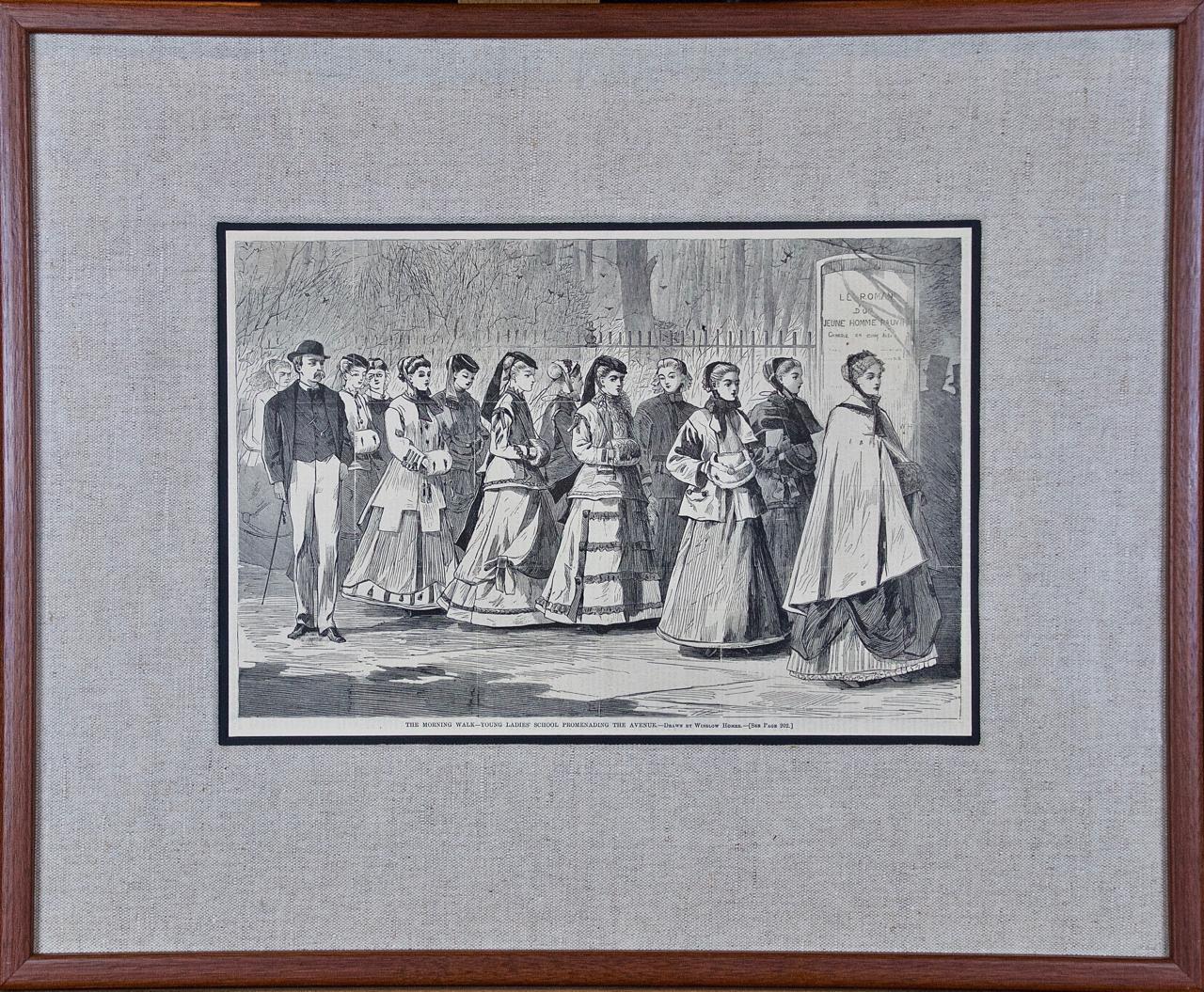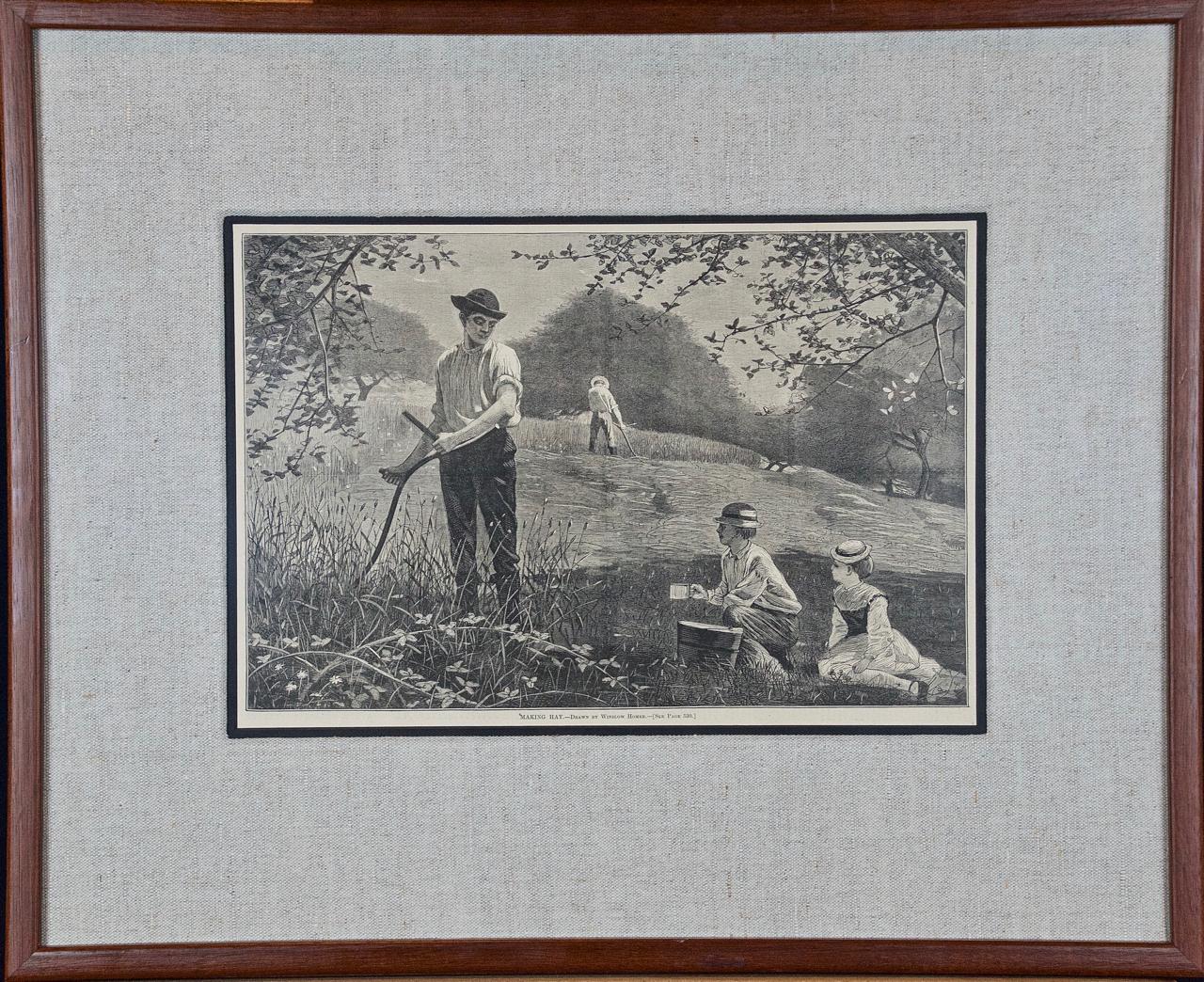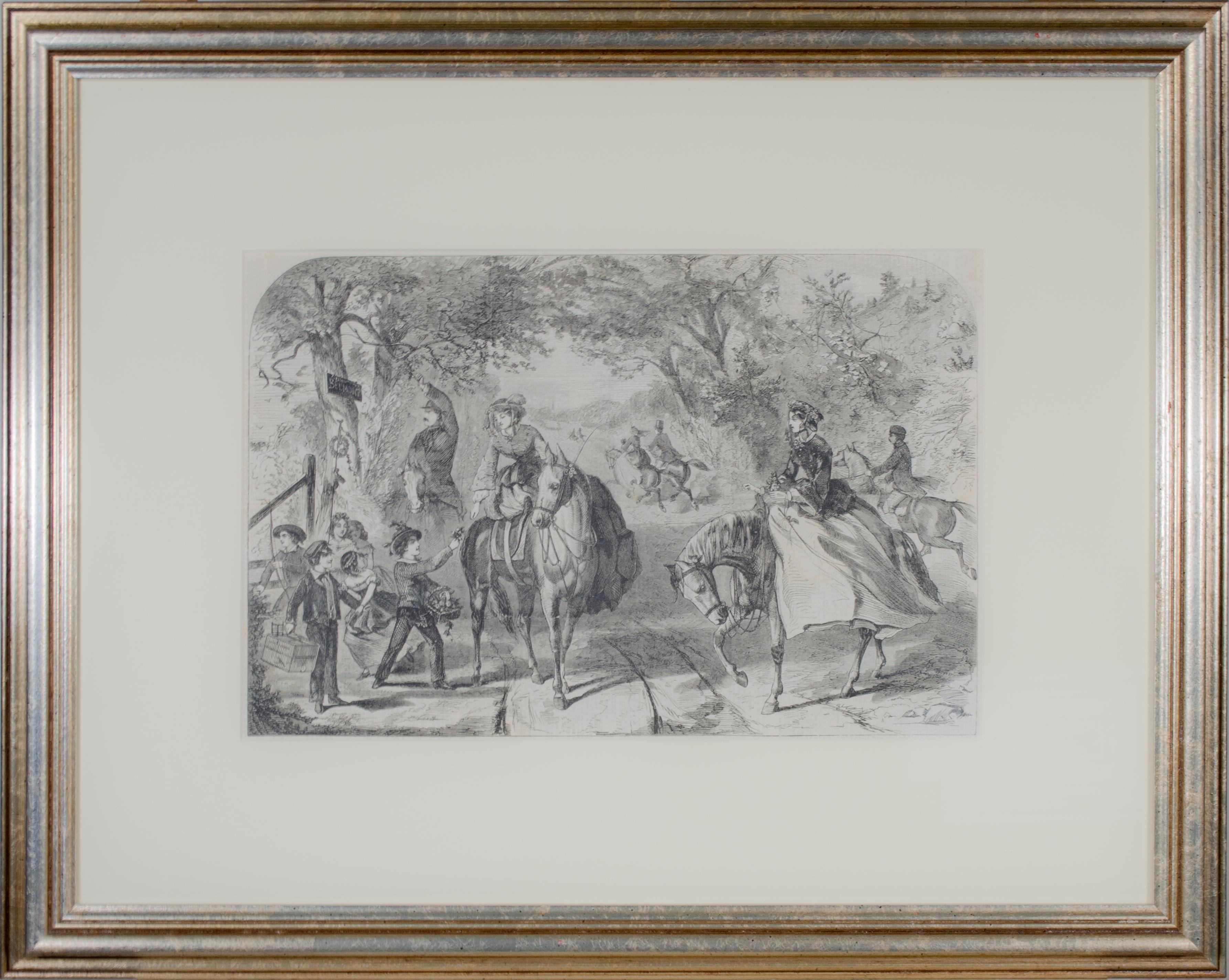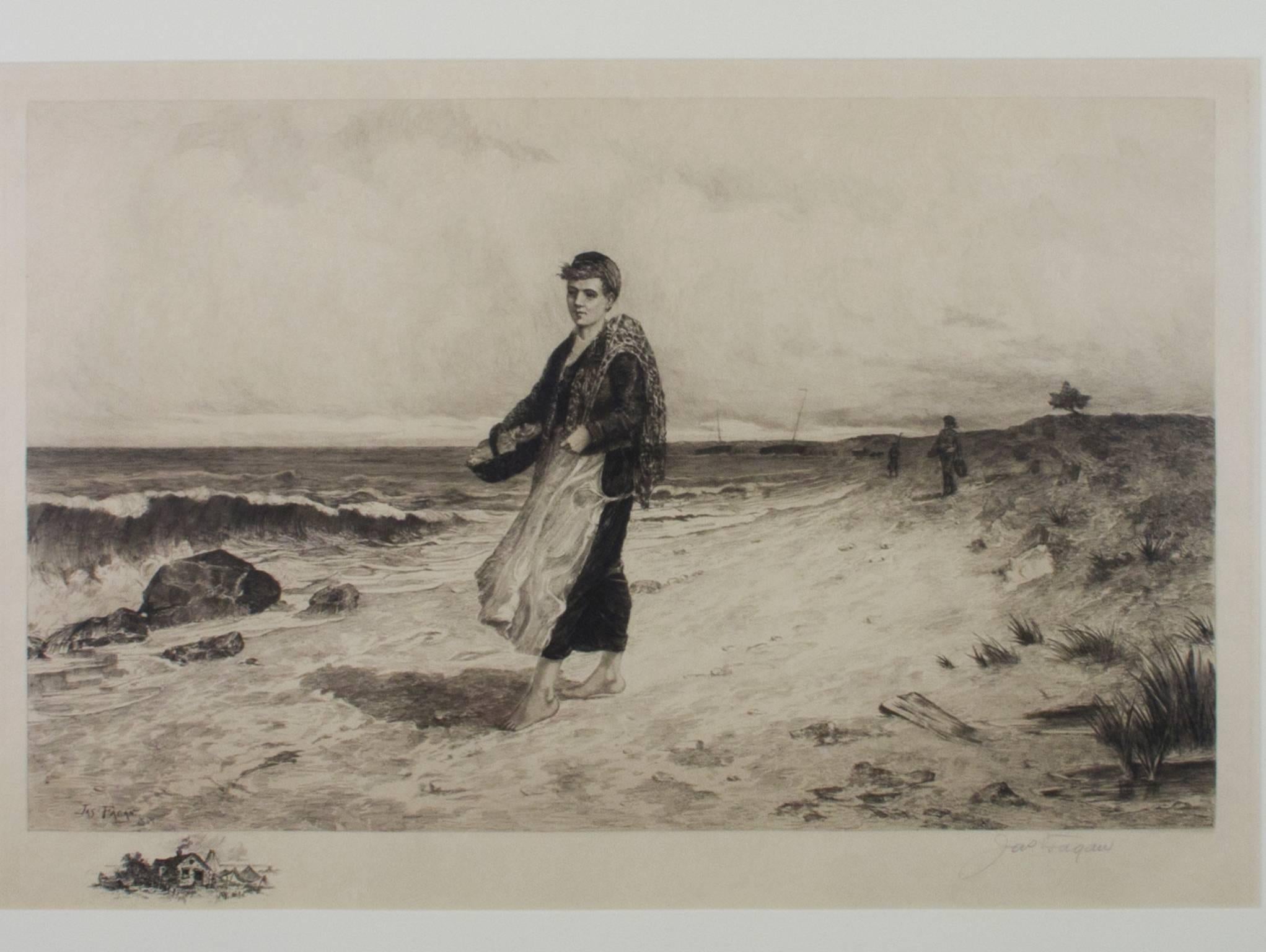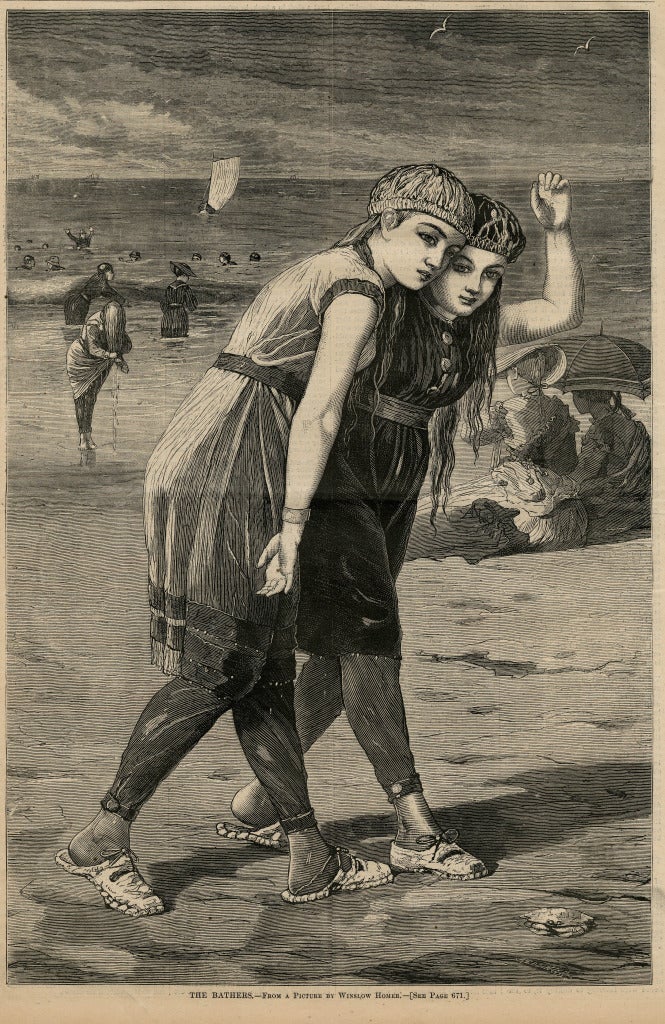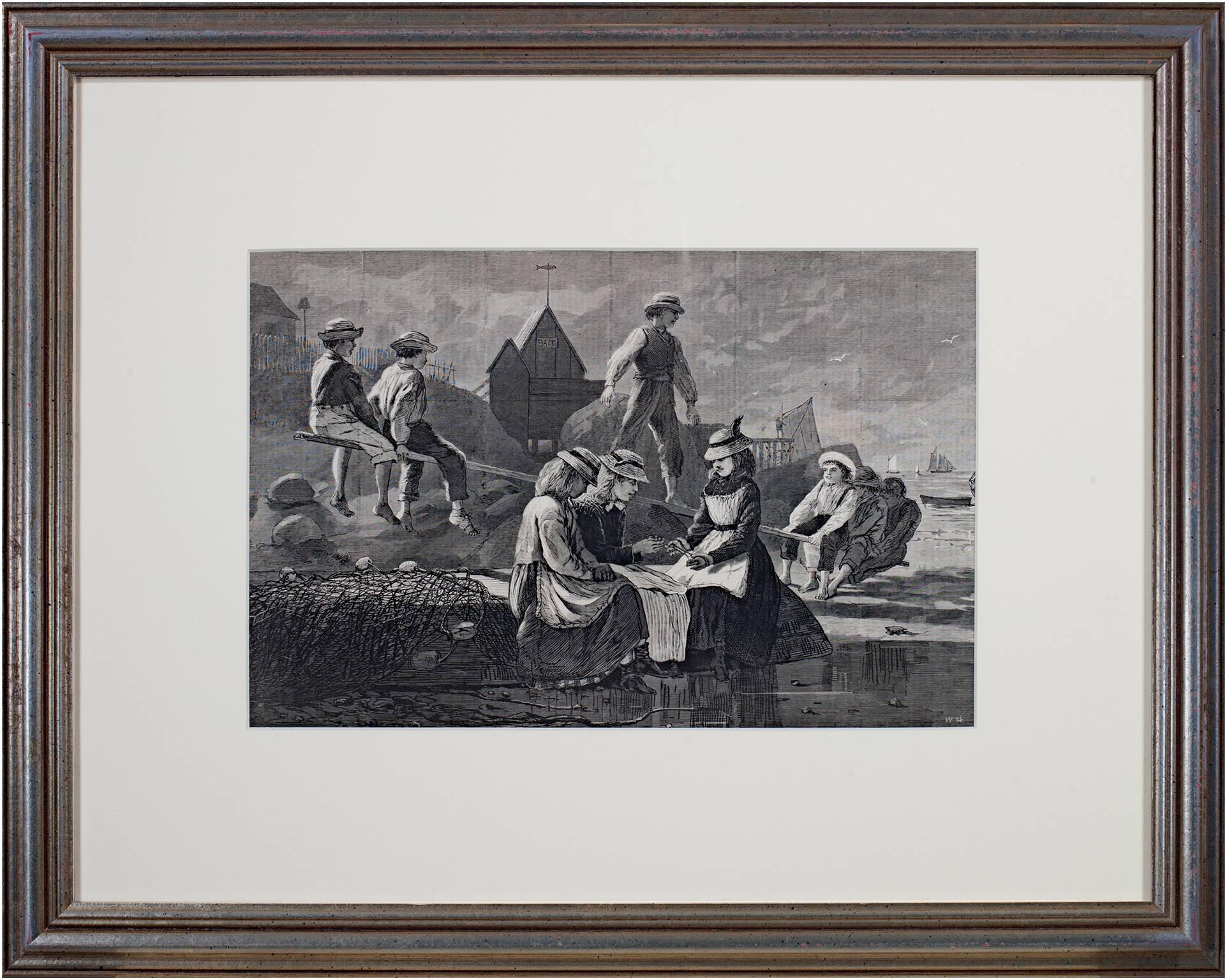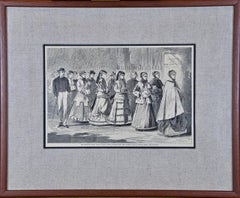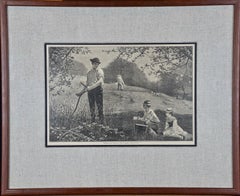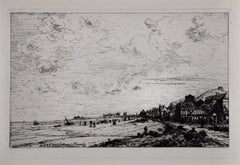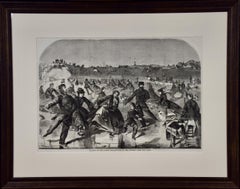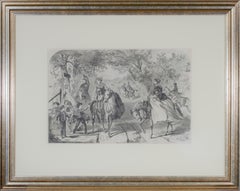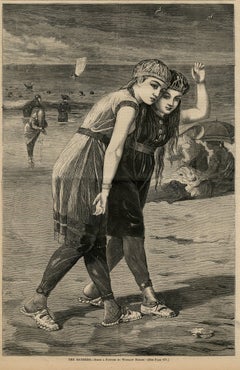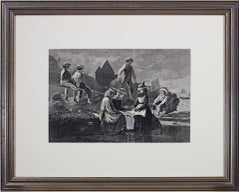Items Similar to Winslow Homer Framed Original 19th Century Wood Engraving "On the Beach"
Want more images or videos?
Request additional images or videos from the seller
1 of 9
Winslow Homer Framed Original 19th Century Wood Engraving "On the Beach"1874
1874
$975
£738.75
€847.65
CA$1,371.98
A$1,508.19
CHF 792.63
MX$18,314.87
NOK 9,887.90
SEK 9,368.09
DKK 6,326.26
About the Item
This Winslow Homer wood engraving entitled "On the Beach at Long Branch, The Children's Hour", was published in Harper's Weekly in the August 15, 1874 edition. It depicts women and their children on the beach. Adults and children are all fully dressed, the style in the 19th century. Many of the women hold umbrellas. Cabanas are seen on the right and a steamship courses through the water in the background on the left.
This beautiful Homer wood engraving is presented in a brown wood frame and a light beige fabric mat with a black inner mat. The frame measures 18.5" high, 22.32" wide and 1.57" deep. The print is in excellent condition.
There are two other Homer woodcut engravings in identical frames and mats that are listed on 1stdibs. See LU117326148342 and LU117326148272. These would make a wonderful display grouping. A discount is available for the purchase of two or all three of these prints.
Winslow Homer (1836-1910) was an American landscape painter, printmaker and publication illustrator. He is considered one of the most important American artists of the 19th-century. Largely self-taught Homer initially worked as an illustrator for various publications, including: Harper's Weekly, Frank Leslie's Illustrated Newspaper and Ballou's Pictorial Magazine. He worked for Harper's during the Civil War, producing woodcut engravings depicting the personal experiences of soldiers. He later became a master of oil and watercolor painting, often focussing on maritime themes.
Harper’s Weekly, published in New York, was an extremely popular publication in the nineteenth and early twentieth centuries. In weekly issues Harper’s reported the news, entertained with literature, poetry and art, as well as educating its readers about world affairs and new inventions. It's woodcut engraved illustrations and literature added to its popularity, employing major artists and authors of the time, including Winslow Homer, Charles Dickens, William Makepeace Thackeray and Thomas Nast.
- Creation Year:1874
- Dimensions:Height: 18.5 in (46.99 cm)Width: 22.32 in (56.7 cm)Depth: 1.57 in (3.99 cm)
- Medium:
- Movement & Style:
- After:Winslow Homer (1836 - 1910, American)
- Period:1770-1779
- Condition:
- Gallery Location:Alamo, CA
- Reference Number:Seller: # 35961stDibs: LU117326148332
About the Seller
5.0
Gold Seller
Premium sellers maintaining a 4.3+ rating and 24-hour response times
Established in 2011
1stDibs seller since 2019
291 sales on 1stDibs
Typical response time: 1 hour
- ShippingRetrieving quote...Shipping from: Alamo, CA
- Return Policy
Authenticity Guarantee
In the unlikely event there’s an issue with an item’s authenticity, contact us within 1 year for a full refund. DetailsMoney-Back Guarantee
If your item is not as described, is damaged in transit, or does not arrive, contact us within 7 days for a full refund. Details24-Hour Cancellation
You have a 24-hour grace period in which to reconsider your purchase, with no questions asked.Vetted Professional Sellers
Our world-class sellers must adhere to strict standards for service and quality, maintaining the integrity of our listings.Price-Match Guarantee
If you find that a seller listed the same item for a lower price elsewhere, we’ll match it.Trusted Global Delivery
Our best-in-class carrier network provides specialized shipping options worldwide, including custom delivery.More From This Seller
View AllWinslow Homer 19th Century Woodcut Engraving "The Morning Walk"
By Winslow Homer
Located in Alamo, CA
This Winslow Homer woodcut engraving entitled "The Morning Walk, Young Ladies' School Promenading the Avenue", was published in Harper's Weekly in the...
Category
1870s American Impressionist Landscape Prints
Materials
Engraving, Woodcut
Winslow Homer 19th Century Woodcut Engraving "Making Hay"
By Winslow Homer
Located in Alamo, CA
This Winslow Homer woodcut engraving entitled "Making Hay", was published in Harper's Weekly in the July 6, 1872 edition. It depicts a two men hand cutting high grass on a hill. The man in the foreground is looking at a young boy and a girl (presumably his children), who are sitting on the ground with a picnic basket.
This beautiful Homer woodcut engraving is presented in a brown wood frame and a light beige fabric mat with a black inner mat. The print is in excellent condition.
There are two other Homer woodcut engravings in identical frames and mats that are listed on 1stdibs. See LU117326148332 and LU117326148272. These would make a wonderful display grouping. A discount is available for the purchase of two or all three of these prints.
This Winslow Homer engraving...
Category
1870s American Impressionist Landscape Prints
Materials
Engraving, Woodcut
The Beach in Normandy, France, Near Bayeux: A 19th C. Etching by Maxime Lalanne
By Maxime Lalanne
Located in Alamo, CA
This is a mid 19th century etching entitled "Point de Depart de Guillaume de Normandie, Beuzeval, Emboucher de la Dives Calvados (The point of departure of William of Normandy (William the Conqueror)), created by Maxime Lalanne and published in 'L'Illustration Nouvelle' in 1868 by Alfred Cadart. The etching depicts the beach at Beuzeval in Normandy; with the shore in the foreground on the right lined by a row of houses, the sea at the left, and an expansive sky above. There are people on the beach and sailboats in the water. This is the point of departure of William the Conqueror for his voyage to England in 1066, resulting in his victory over the Anglo-Saxons at the Battle of Hastings and the establishment of Norman rule. The events are memorialized in the Bayeux tapestry, created by William's wife.
This etching is presented in a white mat that is suitable for framing. This excellent impression is printed on thick chain-linked, laid cream-colored paper with wide margins. It is signed in plate in the lower right and titled in the plate in the lower left. There is a collector's stamp (either an "NC" or a "CN") in the lower right corner. The sheet measures 9.5" high by 12.75" wide and the mat measures 13.5" high by 16" wide. There are two tiny faint spots in the periphery of the upper margin, but the print is otherwise in excellent condition. This etching is held by many museums and institutions, including The British Museum, The Yale University Art Gallery, The Cleveland Museum of Art, The Philadelphia Museum of Art, Columbia University Libraries and The William Morris Gallery...
Category
Late 19th Century Landscape Prints
Materials
Etching
"Skating on Ladies' Pond Central Park": Winslow Homer 19th C. Woodcut Engraving
By Winslow Homer
Located in Alamo, CA
This Winslow Homer woodcut engraving entitled "Skating on the Ladies' Skating-Pond in Central Park, New York", was published in Harper's Weekly in the January 28, 1860 edition. It depicts a large number of men, women and children skating on a recently opened pond in Central Park. At the time of publication of this engraving, Central Park was in the early stages of construction. This engraving documents the very early appearance of Frederick Law Olmstead and Calvert Vaux's masterpiece of landscape design. According to Olmsted, the park was "of great importance as the first real Park made in this century – a democratic development of the highest significance". The people of New York were very proud of the plans for their park. It was stated at the time: "Our Park, which is progressing very satisfactorily under the management of the Commissioners, will undoubtedly be, one of these days, one of the finest place of the kind in the world...Those who saw the Park before the engineers went to work on it are amazed at the beautiful sites which have been contrived with such unpromising materials; all fair persons believe that the enterprise is managed with honesty and good taste."
Skating was rapidly rising in national popularity in part due to the opening of Central Park’s lake to skaters on a Sunday in December 1858 with 300 participants. The following Sunday it attracted ten thousand skaters. By Christmas Day, a reported 50,000 people came to the park, most of them to skate. There were rules governing who could use the skating pond. “The Ladies’ Pond...
Category
1870s American Impressionist Landscape Prints
Materials
Engraving, Woodcut
Fishing Off Hastings, England: A Framed 19th C. Engraving After J. M. W. Turner
By J.M.W. Turner
Located in Alamo, CA
This beautiful 19th century framed engraving "Line Fishing Off Hastings" by William Miller is based on an original painting by the renowned British artist J.M.W. Turner, which depicts a scene of fishermen at work off the coast of the town of Hastings in East Sussex, England. The Miller engraving faithfully reproduces Turner's painting, capturing the same atmospheric quality and sense of motion. In the foreground of the image, a group of fishermen are shown in a small boat, with one man using a fishing line to catch fish. In the background, there is a larger ship, along with a view of the town of Hastings and the cliffs beyond. Overall, the Miller engraving "Line Fishing Off Hastings" is a beautiful and detailed representation of Turner's original painting, and provides a glimpse into life in a 19th century fishing community.
This colorful 19th century engraving is presented in a gold-colored wood frame and a cream-colored French mat highlighted with a light blue band and thinner mustard and gold-colored bands. There is a gold-colored fillet which further embellishes the engraving. The frame measures 18" high, 20.5" wide and 1" deep. The engraving, frame and mat are in excellent condition.
Joseph Mallord William (J.M.W.) Turner (1775-1851) was an English painter who is widely considered one of the greatest landscape painters in Western art history. Born in London, he showed a remarkable talent for art from a young age, and studied at the Royal Academy of Arts from the age of 14. He quickly gained recognition for his watercolor landscapes, which were highly innovative and expressive. Turner's style evolved over time, and he became increasingly interested in the effects of light and color. He traveled extensively throughout Europe, and his experiences of the natural world, particularly the sea and the sky, had a profound influence on his art. His paintings are known for their luminosity, atmospheric effects, and dramatic use of color. Despite facing criticism and ridicule from some of his contemporaries, Turner continued to push the boundaries of art, experimenting with new techniques and styles throughout his career. He was a prolific artist, creating thousands of paintings, sketches, and watercolors, and his legacy continues to inspire artists today.
William Miller (1796-1882) was an English engraver and publisher, best known for his work in reproducing the paintings of J.M.W. Turner. Miller was born in Bristol and began his career as an engraver at a young age, working for a variety of publications and artists. In the early 1820s, Miller began working with Turner, engraving many of the artist's most famous works, including "The Fighting Temeraire...
Category
Mid-19th Century Romantic Landscape Prints
Materials
Engraving
A Signed Etching of a Pastoral Scene in Picardy, France by Paul Emile Lecomte
By Paul Emile Lecomte
Located in Alamo, CA
A beautiful aquatint etching of a serene pastoral scene in the Picardy region of northern France by Paul Emile Lecomte (1877-1950). A mother and child are seen walking down a path in...
Category
Early 20th Century Impressionist Landscape Prints
Materials
Aquatint
You May Also Like
19th century woodcut engraving print figurative American forest trees scene
By Winslow Homer
Located in Milwaukee, WI
The present woodcut engraving is an original print designed by Winslow Homer, originally published in Harper's Weekly on April 30, 1859. It is an excellent example of the many prints Homer produced of fashionable people engaged in leisurely activities, in this case along a picturesque countryside lane. The sign reading 'Belmont' on the left indicates this is probably near his home in Belmont Massachusetts. The image presents multiple figures, both men and women, riding horseback: Some in the distance gallop away, toward a town marked by a church steeple beyond. Three others in the foreground, including two equestrian women, gather around a group of children who have been gathering flowers and trapping birds...
Category
1850s Victorian Figurative Prints
Materials
Woodcut, Engraving
19th century etching black and white seascape print figure waves rocks signed
By James Fagan
Located in Milwaukee, WI
"The Fisherman's Catch" is a signed (in pencil lower right and in plate lower left) etching by James Fagan. It depicts a fisherman walking on a beach in black and white. It is signed...
Category
1880s American Realist Landscape Prints
Materials
Etching
The Bathers
By Winslow Homer
Located in Fairlawn, OH
The Bathers
Woodengraving, 1873
As published in Harper's Weekly, August 2, 1873 (p. 668)
Provenance:
Wunderlich & Co., Inc., New York, NY (Their stock no. 84.003.8 in pencil recto a...
Category
1870s American Realist Figurative Prints
Materials
Woodcut
19th century engraving figurative landscape Victorian urban city scene signed
By Winslow Homer
Located in Milwaukee, WI
"SEESAW--Gloucester, Massachusetts" is an original wood engraving after Winslow Homer. The artist initialed the piece in the lower right. This print depicts six children on a seesaw ...
Category
1870s Academic Figurative Prints
Materials
Engraving
The Beach at Long Branch
By Winslow Homer
Located in Fairlawn, OH
The Beach at Long Branch
Woodengraving, 1869
Signed in the block lower right "WH" ( see photo )
Published in Appleton’s Journal of Literature, Science and Art, August 21, 1869
Condit...
Category
1860s American Realist Figurative Prints
Materials
Engraving
On the Beach at Long Branch - The Children's Hour
By Winslow Homer
Located in Fairlawn, OH
On the Beach at Long Branch - The Children's Hour
Wood engraving, 1874
Published in "Harper's Weekly" August 15, 1874 (p. 672)
Image size: 9 1/4 x 13 5/8 inches
Provenance: Wunderlic...
Category
1870s Hudson River School Figurative Prints
Materials
Woodcut
